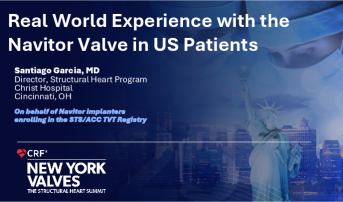Promising Early Data With Navitor TAVI Valves
Permanent pacemaker rates were nearly 18% at 30 days but came down as sites gained experience with the new device.

NEW YORK, NY—Real-world TAVI experience with the self-expanding Navitor valve (Abbott) shows a high rate of technical success with few events at 30 days, according to registry data.
In almost 3,000 patients treated with the device, the rate of all-cause mortality or stroke was 5.2% at 30 days, while 17.8% needed a new permanent pacemaker, Santiago Garcia, MD (Christ Hospital, Cincinnati, OH), reported last week at New York Valves 2025.
“[Our] experience is characterized by [a] high technical success rate, low serious clinical events at 30 days, excellent hemodynamics, and low rates of paravalvular regurgitation,” Garcia said. “We also noticed that the significant increase in rates of pacemaker decreased with device experience. Therefore, Navitor Vision offers [a] safe and effective treatment option for the patient with severe symptomatic aortic stenosis and high surgical risk.”
The Navitor system, which features an active sealing cuff designed to reduce paravalvular leak, was approved by the US Food and Drug Administration in January 2023 for patients with severe aortic stenosis at high risk for surgery after it had received CE Mark approval in Europe in 2021. The current iteration of the device is called the Navitor Vision, which has radiopaque markers for clear implant visualization, and both it and the Navitor Classic valves replaced the Portico system.
To look at early outcomes in a real-world setting, the researchers turned to the STS/ACC TVT Registry. In all, 2,958 patients (mean age 81.4 years; 62.4% female) with tricuspid valve morphology undergoing isolated TAVI at one of 198 US centers were treated with either the Navitor Classic (n = 2,237) or newer-generation Vision valve (n = 721) between January 2023 and December 2024. Baseline mean STS score was 6.6 and LVEF was 58.5%.
CT characteristics at baseline were “consistent with the small aortic annuli population,” Garcia said, with a mean annular diameter of 20.8 mm and annular area of 418.5 mm2.
Average procedure time was 65.8 minutes, including 17.7 minutes of fluoroscopy time, and 73.6% of patients had conscious sedation. Most patients received either the 25-mm (28.7%) or 27-mm (35.0%) devices. The need to recapture the device was “somewhat uncommon” at 17.7%, according to Garcia.
Intraprocedural adverse events were “exceedingly uncommon,” he continued, with a second valve required in only 0.1% of patients. Procedural mortality and conversion to surgery were also rare at 0.1% each. The rate of major vascular complications was 1.7%.
At 30 days, rates of all-cause mortality or stroke were 2.8% and 2.7%, respectively. Life-threatening or major bleeding occurred in 0.7% and aortic valve reintervention was required in 0.3%.
Permanent pacemaker implantation rates were lower among patients without baseline conduction defects—14.5% for the Navitor Classic and 12.3% for the Navitor Vision—and decreased with greater site experience. Specifically, in hospitals with 21 or more logged cases, the need for pacemakers dropped significantly compared to hospitals with 20 or fewer cases for both the Classic (13.5% vs 19.4%; P = 0.0039) and Vision (10.6% vs 19.1%; P = 0.047) valves.
On echocardiography at 30 days, mean gradient remained low at 7.3 mm Hg and effective orifice area rose to 1.98 cm2.
Less than 2% of patients reported moderate or severe paravalvular leak at both discharge and 30 days. Additionally, both the Kansas City Cardiomyopathy Questionnaire score and NYHA class improved between baseline and 30 days (P < 0.001).
Garcia stressed that predilatation should be done in the “majority” of cases to achieve optimal results with this valve. Discussant Ole De Backer, MD, PhD (University of Copenhagen, Denmark), called the safety “impressive” and the efficacy “more than satisfying.”
Future data from the ENVISION IDE trial will show safety and efficacy of the Navitor system in 1,500 patients considered to be at intermediate or low risk for surgery.
Yael L. Maxwell is Senior Medical Journalist for TCTMD and Section Editor of TCTMD's Fellows Forum. She served as the inaugural…
Read Full BioSources
Garcia S. Real world experience with the Navitor valve in US patients. Presented at: New York Valves 2025. June 25, 2025. New York, NY.
Disclosures
- Garcia reports receiving institutional grants and consultant fees/honoraria from Edwards Lifesciences, Abbott, Medtronic, and Boston Scientific.






Comments